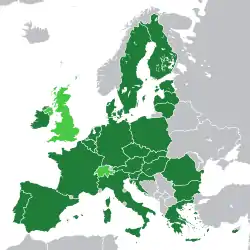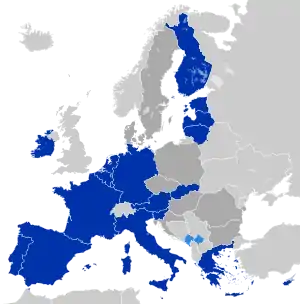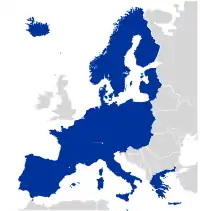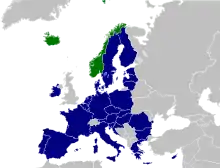Court of Justice of the European Union
The Court of Justice of the European Union (CJEU) (French: Cour de justice de l'Union européenne or "CJUE"; Latin: Curia[2]) is the judicial branch of the European Union (EU). Seated in the Kirchberg quarter of Luxembourg City, Luxembourg, this EU institution consists of two separate courts: the Court of Justice and the General Court.[3][4] From 2005 to 2016 it also contained the Civil Service Tribunal. It has a sui generis court system, meaning ’of its own kind’, and is a supranational institution.[5]
 Emblem of the Court of Justice of the European Union | |
%252C_November_2006.jpg.webp) Palais de la Cour de Justice, Luxembourg | |
| Judicial branch overview | |
|---|---|
| Formed | 1952 |
| Jurisdiction | European Union and Northern Ireland[lower-alpha 1] |
| Headquarters | Kirchberg, Luxembourg City, Luxembourg 49°37′15.41″N 6°8′28.48″E |
| Employees | 2,144 (2015) |
| Annual budget | EUR 357,060,000 (2015) |
| Child agencies | |
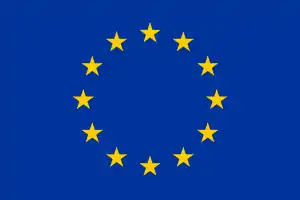 |
|---|
| This article is part of a series on the politics and government of the European Union |
|
|
The CJEU is the chief judicial authority of the European Union and oversees the uniform application and interpretation of European Union law, in co-operation with the national judiciary of the member states.[4] CJEU also resolves legal disputes between national governments and EU institutions, and may take action against EU institutions on behalf of individuals, companies or organisations whose rights have been infringed.[6]
Composition
The CJEU consists of two major courts:[7]
- the Court of Justice, informally known as European Court of Justice (ECJ) which hears applications from national courts for preliminary rulings, annulment and appeals. It consists of one judge from each EU member country, as well as 11 advocates general.
- the General Court, which hears applications for annulment from individuals, companies and, less commonly, national governments (focusing on competition law, state aid, trade, agriculture and trade marks). Since 2019 the court consists of 49 judges.
Functions
The CJEU's specific mission is to ensure that "the law is observed" "in the interpretation and application" of the Treaties of the European Union. To achieve this, it:
- reviews the legality of actions taken by the EU's institutions;
- enforces compliance by member states with their obligations under the Treaties, and
- interprets European Union law.[4]
History
The CJEU was originally established in 1952 as a single court called the Court of Justice of the European Coal and Steel Communities (as of 1958 the Court of Justice of the European Communities (CJEC)).
The General Court was created in 1988 (known as the Court of First Instance) and the Civil Service Tribunal was created in 2004.
With the entry into force of the Treaty of Lisbon in 2009, the court system obtained its current name (Court of Justice of the European Union), while the original court itself (the former CJEC) was renamed "Court of Justice".
The working language of the Court of Justice of the European Union is French.[8]
Notes
- Under the terms of the Protocol on Ireland/Northern Ireland, concluded as part of the Brexit withdrawal agreement, the CJEU continues to have jurisdiction over the operation of EU law applying to Northern Ireland in relation to customs and the movement of goods, technical regulations, VAT and excise, the Single Electricity Market and State aid, and may hear applications for preliminary rulings made by Northern Irish courts.[1]
References
- House of Lords European Union Committee (1 June 2020). 9th Report of Session 2019–21: The Protocol on Ireland/Northern Ireland (Report). House of Lords. p. 65. Retrieved 2 January 2021.
The Protocol will also confer full jurisdiction on the CJEU to oversee the operation of EU law applying to Northern Ireland in relation to customs and the movement of goods, technical regulations, VAT and excise, the Single Electricity Market and State aid; including the jurisdiction to hear applications for preliminary rulings submitted by the courts of Northern Ireland. The UK will have the right to participate in these proceedings as if it were a Member State.
- http://www.curia.europa.eu
- Article 19 TEU: The Court of Justice of the European Union shall include the Court of Justice, the General Court and specialised court.
- "General Presentation". Curia. Europa. Retrieved 23 October 2015.
- Malta u l-Qorti tal-Ġustizzja tal-Unjoni Ewropea (PDF) (in Maltese). Luxembourg: Publications Office of the European Union. 2014. p. 412. ISBN 978-92-829-1733-6. OCLC 904335289. Archived from the original (PDF) on 3 April 2016.
- "Court of Justice of the European Union (CJEU)". Europa. Europa. Retrieved 23 October 2015.
- "Court of Justice of the European Union (CJEU)". Europa.eu. Retrieved 13 March 2017.
- "Language arrangements at the Court of Justice of the European Union". Curia. Europa. Retrieved 8 September 2018.
Further reading
- Beck, Gunnar (2013). The Legal Reasoning of the Court of Justice of the EU. Oxford: Hart Publishing.
- Mikelsone, Gundega (2013). The Binding Force of the Case Law of the Court of Justice of the European Union. ISSN 2029-2058.
External links
| Wikisource has original text related to this article: |
- Official website
- Access to documents of the Court of Justice of the EU on EUR-Lex
- The archival fonds of the Court of Justice of the European Union is consultable at the Historical Archives of the European Union

